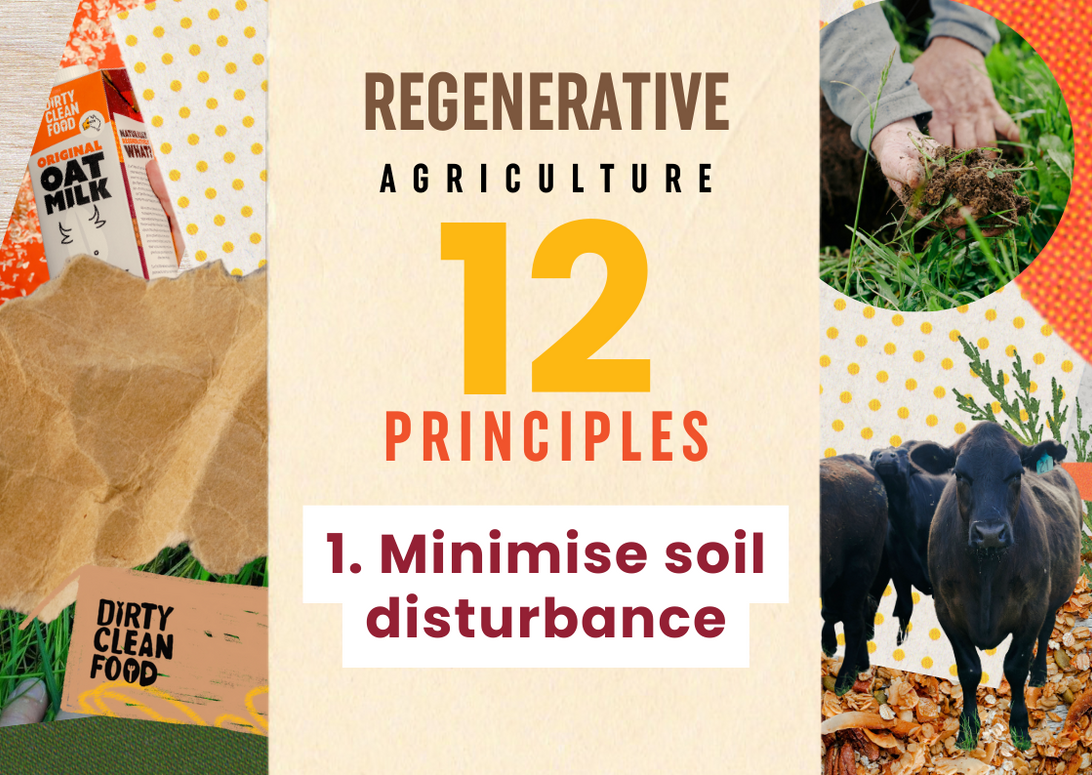
Regen Ag #1- Why Minimising Soil Disturbance Transforms Farming
|
Time to read 4 min
|
Time to read 4 min
Welcome to our 12 Principles of Regenerative Agriculture series- where we define "regen ag" and show you how regenerative farming changes the planet, the system, and our food.
One of the most important regenerative principles that our farmers strive towards under the heading of Soil Health is to minimize soil disturbance. This is because healthy soil should be a thriving ecosystem, with microbes and fungi holding the soil structure together, transporting water, minerals and nutrients to and between plants.
All the good stuff that makes soil a thriving environment of life and growth lives and grows in the soil, just as crops do. Good soil has a healthy balance of organic matter and diversity, this produces the best healthy crops just like a balanced diet is essential to one's health.
Keen home gardeners and growers may be familiar with 'no dig' or 'no till' as a method of growing crops with minimal soil disturbance. What we focus on at Dirty Clean Food is how to minimise soil disturbance at a commercial level, working in collaboration with our farmers to implement these principles at a larger scale.
The purpose of tilling is to mix organic matter into your soil, help control weeds, break up crusted soil, or loosen up a small area for planting. The process involves disturbing the top layer of soil to create the mix. Tilling too often or deep can do more damage than good to your soil.
Tilling or digging over the soil breaks up the spaces between the soil particles where the microbes live - imagine a good soil structure like a city of multi-story apartments, with the microbes happily watching Netflix in their own private residences. Getting your shovel in there and turning everything over is the equivalent of demolishing that city, with the microbes having to re-build their homes before they can get back to their favourite series again.
For our oats and lupins farmers, Minimizing Soil Disturbance means transitioning towards zero till cropping, which disturbs the soil even less than no-till. The main difference here is in the machinery used, specifically the seeding rig. "Zero till" refers to using a disc seeder, which is a seeding bar featuring a disc that slices open a slot in the soil for seed and fertilizer placement. This slot is then closed by a trailing wheel. This disturbs the ground around the seed as little as possible, allowing the microbes and soil structure to remain intact around where the seed has been planted. This moves beyond ‘No till’, which usually refers to not tilling (not turning over the soil). ‘No till’ however usually still uses knife points, narrow steel fingers that are driven into the soil to sow the seed, which do still disturb the soil much more than discs.
There is a one-off exception to applying a "zero dig" method to our Dirty Clean Food farmers:
Plant roots and microbes need air, water and food to grow and flourish. An ideal growing medium is light, fluffy aerated soil, with a good amount of organic matter and clay particles to hold water. Heavily compacted soil won’t be able to grow happy deep-rooted plants that host beneficial microbes. So, as a once off to break up compaction, a farmer may choose to deep rip their paddock. It’s then how they manage the plants going forward that allows them to retire the tynes in favour of discs. Below is an example of using a disc seeder on oat farmer Jamie Anderson’s farm to sow a multi species summer cover crop into dry pasture – you can’t even see where the discs have passed through the pasture.
For our beef and egg farmers Blythe and Gregg, 'Minimise Soil Disturbance' has been their focus when trying to get a multi species annual and perennial pasture established within their existing kikuyu pasture.
Their kikuyu is very vigorous in the growing season, and out competes any other plant that is trying to grow. Their soil was left anaerobic, compacted, and with a deep layer of kikuyu thatch after previous years in operation as a dairy farm, with flood irrigation used at fortnightly intervals,
Blythe and Gregg have invested in a Soilkee Renovator to help them establish their desired pasture in amongst the kikuyu. The Soilkee Renovator is a Pasture Cropping System that plants seasonal crop and pasture seeds into existing pasture; filling feed gaps and reducing paddock down time traditionally associated with pasture renovation. This machine tills several narrow strips of soil, while leaving around 80% of the pasture undisturbed. A diverse mix of seeds from clover seed to faba bean size can be seeded by the machine after the narrow strip has been tilled.
The undisturbed portion acts as a cover crop, protecting the soil from the elements, reducing erosion and keeping around 80% of soil life habitat intact. Creating the seed bed provides the added benefits of aeration, and the kikuyu thatch becomes a green manure crop within the worked-up portion, providing aerobic conditions and a food source that activates the soil fungi, bacteria and earthworm populations and the natural soil processes they perform. Here, you can see the new pasture growing through the kikuyu thatch.
We hope you’ve enjoyed learning more about what it means to be a Dirty Clean Food regenerative farmer, and we look forward to showing you more in our next feature on 'Principle 2: Keeping the Soil Covered' year round.
‘Regenerative agriculture is an ecological approach to farming that allows landscapes to renew themselves.’


